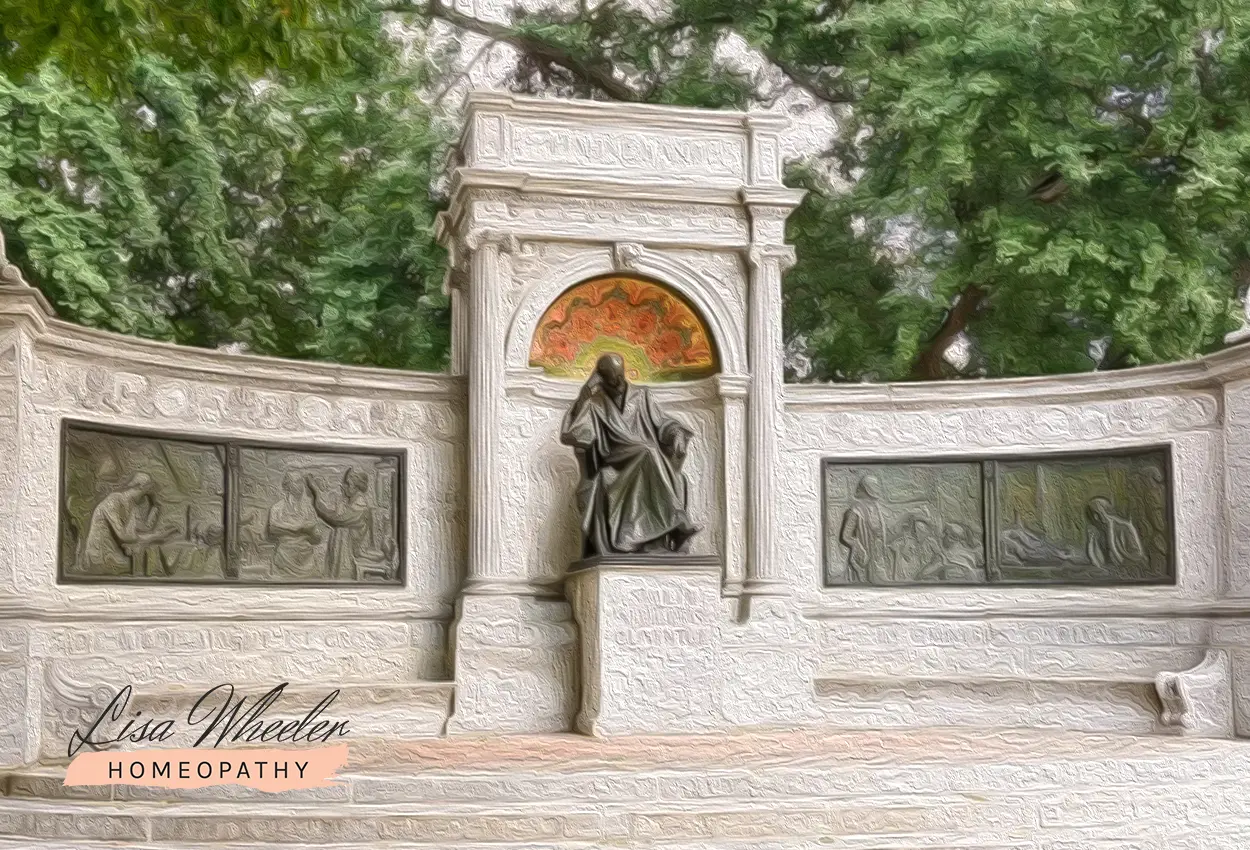The Founder of Homeopathic Medicine Whose Birthday was at Midnight in-between April 10th and 11th, 1755. Happy Birthday to one of the greatest physicians of all time, Samuel Hahnemannm MD.
In America’s capital city, Washington, DC, the only monument honoring a physician is one to the founder of homeopathic medicine, Samuel Hahnemann, MD (1755–1843). This monument was dedicated in 1900 by President William McKinley … and resides Scott Circle at the corner of Massachusetts Avenue and 16th St. N.W.
Although trained as a medical doctor, Hahnemann was a learned chemist and author of the leading German textbook for apothecaries (pharmacists) of the day. He was conversant in at least nine languages and even supported himself in his mid-twenties teaching languages at the famed University of Leipzig.
Learning languages enabled Hahnemann to become familiar with the latest developments in medicine and science. He further expanded his knowledge and his growing prestige by translating twenty-two textbooks, primarily medical and chemistry textbooks (several of which were multi-volume works). Over a twenty-nine-year period, Hahnemann translated some 9,460 pages.
Prior to his discovery of homeopathy, Hahnemann’s respect as a physician brought German royalty to seek his medical care, and modern medical historians confirm that Hahnemann showed sound balance and good judgment in his advocacy of proper diet, fresh air, and exercise as a method of treatment. His promotion of hygienic measures during epidemics won him praise as a public health advocate, and his kind, rather than cruel and harsh, treatment of the insane granted him a place in the history of psychiatry (Rothstein, 1972, 152).
It is not surprising to know that Hahnemann was a Freemason as early as 1777; he was later granted the title of Obermeister, or Grand Master (Jurj, 2007). In this esoteric fraternal organization and secret society, men shared certain moral and metaphysical ideals.
Hahnemann stopped practicing conventional medicine of his day because he felt that he was doing more harm than good. Instead, he made a living for his family of eleven children as a translator. During the translation of a book by William Cullen, the leading physiologist of that time, Hahnemann noted that Cullen asserted that Peruvian bark was an effective drug for malaria because of its bitter and astringent properties. Hahnemann thought this a peculiar statement because he knew other bitter and astringent medicines that provided no benefit in the treatment of malaria. He then conducted an experiment upon himself, taking this herb twice a day until he developed symptoms of its toxicology, and here he discovered that it created a fever with chills as well as other symptoms that mimicked malaria. Hahnemann proposed that Peruvian bark (which contains quinine) may be effective for treating people with malaria because it has the capacity to cause similar symptoms.
Hahnemann ultimately conducted upon himself experiments with ninety other substances, and his colleagues and friends also engaged in these experiments. He found a consistent pattern from these experiments: that various substances in overdose create their own unique syndrome of symptoms and whatever syndrome a substance causes in toxic dose, it can and will elicit a healing response when given in specially prepared small doses to people who have similar symptoms of pathology.
Hahnemann observed that sick people were hypersensitive to the medicine that causes similar symptoms as they were experiencing. Because of this, Hahnemann began using smaller and smaller doses. Being a chemist, he experimented with various ways to make these doses both safe and effective. Over the next forty years, he experimented with diluting the medicines 1:10, 1:100, or 1:50,000, with vigorous shaking between dilutions, and he consistently found that exceedingly small doses of medicines had powerful therapeutic effects when prescribed according to his principle of similars.
Being an incredibly avid experimenter, Hahnemann did not come easily or quickly to his conclusions about the exceptionally small doses he and his colleagues found effective. In fact, he first wrote about homeopathy in 1796, and for the next thirty years (!) he primarily used doses that are today considered low potencies. Further, in 1829, a homeopathic physician wrote him about his successes in using potencies that were diluted 1:10 more than 200 times, and Hahnemann expressed skepticism for such actions until he himself found that these higher potencies were surprisingly effective (Bradford, 1895, 455–456).
Ultimately, Hahnemann authored three major books on homeopathy, including six editions of his seminal work Organon of the Medical Art, continually updating and refining this science and art.
Christoph Wilhelm Hufeland, MD (1762–1836), Germany’s most well-known and respected physician of his day, was as famous as Goethe and Schiller in the early nineteenth century. As the editor of the leading medical journal in Germany, Journal of Practical Medicine, Hufeland published some of Hahnemann’s writings and held him in extremely high regard: “I have discovered in him an amplitude of knowledge, clearness of mind, and a spirit of tolerance, which last is the more worthy of notice in him.” Hahnemann was described as “one of our most distinguished, intelligent and original physicians” (Everest, 1842, 186).
Even though Robert Koch first discovered the cholera bacteria in 1883, as early as 1831 Hahnemann ascribed the cause of the cholera epidemics raging at that time to “an enormously increased brood of those excessively minute, invisible, living creatures so inimical to human life, of which the contagious matter of the cholera most probably consists” (Hahnemann, 1831).
Nicholas Von Hoffman, a columnist for the Washington Post, wrote: “Although this German physician never visited the U.S., for 70 years or more his ideas tore up and divided American medicine. No other single individual caused the settled and comfortable structures of this profession the trouble Hahnemann did, and even now many of the questions he raised have not been answered” (Von Hoffman, 1971).
Many of homeopathy’s most severe critics have actually had kind words for Samuel Hahnemann. Morris Fishbein, executive director of the American Medical Association, wrote: “The influence of Hahnemann was, on the whole, certainly for the good. He emphasized the individualization of the patient in the handling of disease … and he demonstrated the value of testing the actual virtues of a drug by trial” (Fishbein, 1925, 37).
Of additional interest is the fact that Hahnemann was granted honorary membership into the Medical Society of the County of New York in 1832. However, a few years later, the society rescinded his membership when they determined that homeopathy’s growth represented an “ideological and financial threat” (Kaufman, p. 32)
Despite Hahnemann’s significant contributions to medicine, pharmacy, chemistry, psychiatry, and public health, he remained a humble man. “I do not ask during my lifetime any recognition of the beneficent truth, which I, without any thought of myself, offer. What I have done, I did from higher motives for the world. Non inutilis vixi (I have not lived in vain)” (Neng, 1930).
On the Hahnemann monument in Washington, DC, are those Latin words. Indeed, Dr. Samuel Hahnemann did not live in vain.
(Excerpted by The Homeopathic Revolution, by Dana Ullman, MPH, CCH)
Message or book a consultation Lisa today and learn more about how homeopathy can help you and your entire family.
SHARE THIS POST WITH A FRIEND OR ON SOCIAL MEDIA







